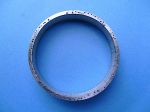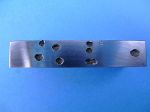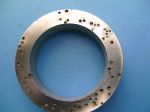Passivation is the process by which a stainless steel will spontaneously form a chemically inactive oxide film on the surface when exposed to air or other oxygen-containing environments provided that the surface has been thoroughly cleaned or descaled. 


![]()
Removal of exogenous iron or iron compounds from the surface of a stainless steel by means of a chemical dissolution, most typically by a treatment with mild oxidant such as a nitric acid solution that will remove the surface contamination but will not significantly affect the stainless steel itself is part of the passivation process.
The chemical treatment will enhance the spontaneous formation of the protective passive film. Before, during or after passivation the components are often contaminated with unacceptable material that may impair the normal corrosion resistance.
NOTE:
Chemcal testing for corrosion resistance overlaps with Corrosion Testing as the methods and aims of the tests are similar please also see the Corrosion Testing Section for further details.
LMATS performs contamination test in Melbourne and Sydney to detect unacceptable free iron, oxide, scale, rust, grease, oil, carbonaceous or other residual chemical films, soil, particles, metal chips, dirt, or other non-volatile deposits in accordance with ASTM A380 Section 7.
LMATS holds proven procedures for High Humidity test, Black light test, Salt Spray test and NATA accreditation in Copper Sulphate test and Ferroxyl test in accordance with ASTM A967 Practice D, EXXON Mobil and ESSO Shell specification.
Corrosion Resistance Testing
LMATS Services
LMATS provide advanced testing and inspection services in Melbourne Victoria, Sydney - NSW and Brisbane Queensland, Tasmania, South Australia in the following Sectors:
-
Advanced NDT - ECA Eddy Current Array test
-
Advanced NDT - PAUT Phased Array Ultrasonic test
-
Advanced NDT - TOFD Time of Flight Diffraction
-
Advanced NDT - CRT Computed Radiographic testing
-
NDT - Non-destructive testing - RT, UT, ET, MT, PT
-
Coatings Inspection - NACE
-
Pressure vessel Inspection AICIP & Conformity
-
Chemical analysis (Spark Spectroscopy)
-
Third party Inspection & expert Witness
-
Quality Audit & NDT Level 3 services
-
Hydrostatic pressure test
-
PMI - Positive Material Identification (XRF).
-
Weld (WPS / WPQR) qualification test
-
Mechanical testing (engineering)
-
Corrosion Resistance Test
-
Metallurgical services
-
Failure investigation
-
Concrete testing - GPR, thickness, strength.
Advanced NDT Capabilities
Guided Wave LRUT, PEC (Pulsed Eddy current), ECA (Eddy Current Array), ACFM, ACPD, PAUT, Hydroform, TOFD, CRT, Heat exchanger tube testing - IRIS, RFT, NFT, NFA (Near Field Array), MFL tank floor, SteerRover.
LMATS has a wide range of innovative advanced NDT capabilities. Call us on 1300 707 365 to find out more, or explore LMATS Advanced NDT Solutions.

